Nature & Parks
State of Global Environment at a Glance: Wildlife Protection
1. Basic Policy
The protection of valuable wildlife requires the protection of habitat, strict regulation of hunting, control of illegal poaching, and implementation of measures necessary to preserve endangered species.
The Japanese wildlife protection system provides for the conservation of wildlife by enforcing the Wildlife Protection and Hunting Law and the Law for Conservation of Endangered Species of Wild Fauna and Flora.
Ministry of the Environment has promoted cooperation with neighboring countries to conserve migratory birds and to protect endangered species, particularly in developing countries.
Wildlife Protection System of Japan
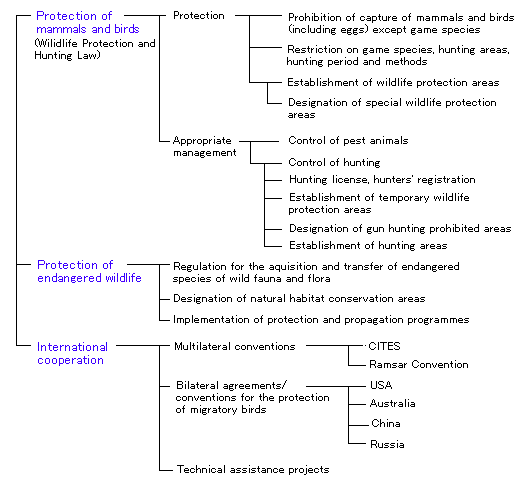
2. Protection System of Mammals and Birds
(A) Outline
More than 600 species of wild mammals and birds inhabiting Japan are strictly protected, and hunting or capturing them is prohibited unless permission and/or a license has been granted from wildlife protection authorities.
All species of wild birds and mammals are classified as follows.
(1) Animals excluded from the regulations of the Wildlife Protection and Hunting Law.
Some marine mammals are under the jurisdiction of the Ministry of Agriculture, Forestry, and Fisheries. Rats and insectivorous mammals are also excluded from the Law because they are harmful to agricultural activities.
(2) Game Species
Some examples of the 47 game species are Brown Bear, Black Bear, Shika Deer, Wild Boar, Japanese Hare, Ducks, Green Pheasant, Japanese Quail, and Tree Sparrow.
The list of game species was decided and revised after taking into consideration of such elements as habitat conditions; population; impact on agriculture, forestry, and fisheries; and profits from such game species.
(3) Protected Species
The capturing and hunting of all other species other than those mentioned in (1) and (2) above are prohibited unless special permission has been granted to undertake scientific research, to control the population of harmful species, or to protect human life.
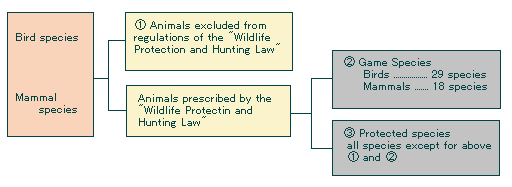
(B) Wildlife Protection Areas
Ministry of the Environment and the prefectural governor are empowered to establish Wildlife Protection Areas and Wildlife Special Protection Areas to promote protection of the wildlife species and their habitats.
Wildlife Protection Areas: Established Wildlife Protection Areas cover 3,579 thousand hectares (3,889 sites) as of March 2002. Within these Areas, all wildlife species are protected and hunting is prohibited.
Wildlife Special Protection Areas: Established Wildlife Special Protection Areas cover 264 thousand hectares (623 sites) as of March 2002. Within these Areas, prior permission is required from Ministry of the Environment or prefectural governors to reclaim water surfaces, cut trees or bamboo, erect structures, etc. in order to preserve these ecosystems.
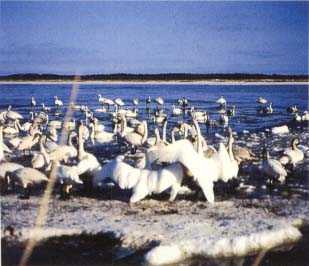
Wildlife Protection Area
(Hamatonbetsu)
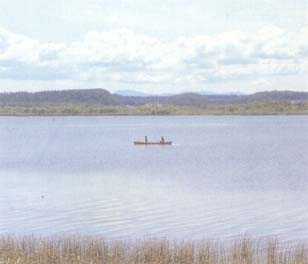
Wildlife Protection Area
(Tohutsuko)
(C) Hunting System
- Hunting license
Under the Japanese hunting system, prospective hunters must first pass a state examination for hunting to ensure safety and quick identification of game species.
In addition, hunters are required to register and pay a hunting tax and registration fee to the prefectural governments of the territory where they intend to hunt. Prefectural governments can issue three kinds of licenses: shotgun and rifle; net and trap; and air gun with compressed air. There approximately 231,000 hunters in Japan.
| License Classification | Hunting Equipment | Number of Licenses Issued (as of 1998) |
|---|---|---|
| A Class | Net, Trap | 26,000 |
| B Class | Shotgun, Rifle | 189,000 |
| C Class | Air gun, Firearm using compressed gas | 16,000 |
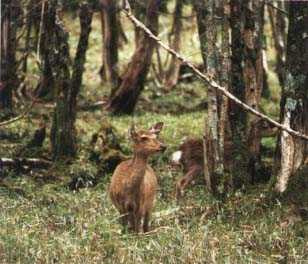
Shika Deer
(Cervus nippon)
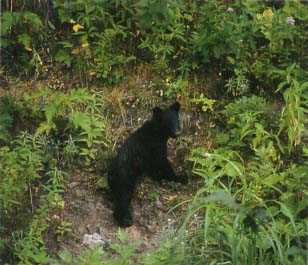
Asian Black Bear
(Selenarctos thibetanus japonicus)
- Strict hunting regulations
The following strict regulations have been established to ensure safe hunting and to maintain game species population.
- (a) Establishment of a hunting season
- (b) Designation of areas where hunting is prohibited
- (c) Prohibition of dangerous devices, equipment, and methods
- (d) Prohibition of mass slaughter and capturing
- (e) Establishment of daily and seasonal limits for game
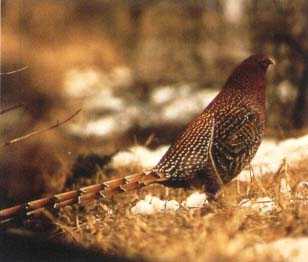
Copper Pheasant
(Syrmaticus soemmerringii scintillans)
3. Protection of Endangered Species
Despite efforts to the contrary, some species are still threatened because of past hunting pressures, habitat degradation or destruction, and toxic agricultural chemicals. Ministry of the Environment published the "Red Data Book of Japan." The Law for Conservation of Endangered Species of Wild Fauna and Flora was established in 1992. This Law and other Laws were established to protect endangered species in Japan.
(A) The Red Data Book of Japan
In 1986, Ministry of the Environment established the Wildlife Protection Division within the Nature Conservation Bureau and initiated a study on threatened fauna and flora of Japan. The study was completed in 1989, and the results were published in 1991 as the "Red Data Book of Japan." The results of this study are reflected in Japan's wildlife protection policy. Ministry of the Enviroment will periodically revise the "Red Data Book of Japan" based on the population trends of threatened fauna and flora.
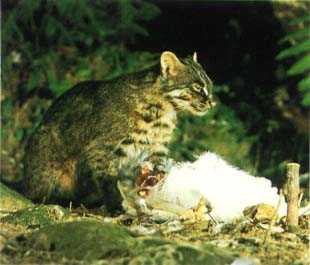
Iriomote Wild Cat
(Mayailurus iriomotensis)
Number of Japanese Taxa Listed in the Red List of Japan
(As of Aug. 2007)
| Known Japanese Taxa | EX | EW | Threatened | NT | DD | Number of Threatened species | ||||
|---|---|---|---|---|---|---|---|---|---|---|
| CR | EN | VU | ||||||||
| Fauna | Mammal | 180 | 4 | 0 | 15 | 20 | 7 | 18 | 9 | 42 |
| Bird | Approx. 700 | 13 | 1 | 21 | 32 | 39 | 18 | 17 | 92 | |
| Reptile | 98 | 0 | 0 | 3 | 10 | 18 | 17 | 5 | 31 | |
| Amphibian | 65 | 0 | 0 | 1 | 9 | 11 | 14 | 1 | 21 | |
| Brackish and Fresh water fish | Approx. 400 | 4 | 0 | 61 | 48 | 35 | 26 | 39 | 144 | |
| Known Japanese Taxa | EX | EW | Threatened | NT | DD | Number of Threatened species | ||||
| CR+EN | VU | |||||||||
| Insect | Approx. 30,000 | 3 | 0 | 110 | 129 | 200 | 122 | 239 | ||
| Inland and fresh water Shellfish | Approx. 1,100 | 22 | 0 | 163 | 214 | 275 | 73 | 377 | ||
| Spiders and crustaceans | Approx. 4,200 | 0 | 1 | 17 | 39 | 40 | 39 | 56 | ||
| Known Japanese Taxa | EX | EW | Threatened | NT | DD | Number of Threatened species | ||||
| CR | EN | VU | ||||||||
| Plants | Vascular plant | Approx. 7,000 | 33 | 8 | 523 | 491 | 676 | 255 | 32 | 1,690 |
| Bryophytes | Approx. 1,800 | 1 | 0 | 118 | 111 | 22 | 33 | 229 | ||
| Algae | Approx. 5,500 | 5 | 1 | 89 | 21 | 40 | 37 | 110 | ||
| Lichen | Approx. 1,500 | 5 | 0 | 41 | 19 | 39 | 48 | 60 | ||
| Fungi | Approx. 16,500 | 30 | 1 | 39 | 25 | 17 | 54 | 64 | ||
| Total 3,155 | ||||||||||
EX: Extinct, EW: Extinct in the Wild, CR: Critically Endangered, EN: Endangered, VU: Vulnerable, NT: Near Threatened, DD: Data Deficient
(B)Law for Conservation of Endangered Species of Wild Fauna and Flora
The Law for the Conservation of Endangered Species of Wild Fauna and Flora recognizes the importance of the different species of wild fauna and flora, and that they are essentially valuable for humanity. The Law aims to ensure the conservation of endangered species of wild fauna and flora and to contribute to the conservation of natural surroundings for present and future generations.
- Definitions
"National Endangered Species" (hereinafter "NES") are designated as those endangered species known to exist in Japan. "International Endangered Species" (hereinafter "IES") are designated as those species listed in CITES (Convention on International Trade in Endangered Species of Wild Fauna and Flora) Appendix I or listed in any Japan's bilateral conventions or agreements with neighboring countries.
- Prohibition on Acquisition and Transfer of Endangered Species
The hunting, gathering, killing, or damaging of live DES is prohibited unless Minister of the Environment has granted permission. And the transfer of endangered species is prohibited unless Minister of the Environment Agency has granted permission for transfer. International trading of DES organisms is prohibited for either commercial or non-commercial purposes unless the conditions established by the Government have been fulfilled.
- Details of Regulations Transfer, etc.,
With regard to those designated as NES and IES, display and advertisement for the purpose of sale or distribution, and transfer, etc. (giving, selling, lending, receiving, and borrowing) is generally prohibited.
| Designation | Display and advertisement | Transfer, etc. | Examples of designated species | |
|---|---|---|---|---|
| National Endangered Species of wild fauna and flora | Designation based on the Migratory Birds Convention, etc. | Prohibited | Prohibited* | Japanese crested ibis (Nipponia nippon), Japanese crane (Grus japonensis), Blakiston's fish owl (Ketupa blakistoni), etc. |
| Species judged to be in danger of extinction | Prohibited | Prohibited* | Iriomote wild cat (Prionailurus bengalensis iriomotensis), Okinawa rail (Gallirallus okinawae), etc. | |
| International Endangered Species of wild fauna and flora | Designation based on the Migratory Birds Convention, etc. | Prohibited | Prohibited* | White-necked crane (Grus vipio), Little tern (Sterna albifrons), Puerto Rican amazon (Amazona vittata), etc. |
| Species listed in the CITES Appendix I |
Generally prohibited* (However, allowed with registered ) | Giant panda (Ailuropoda melanoleuca), Radiated tortoise (Astrochelys radiata), Asian arowana (Scleropages formosus), etc. | ||
*Exemptions from the prohibition of transfer, etc. include those approved by the Minister of the Environment, filed with notification by a university, a museum, etc.
Prohibited from display, advertisement, and transfer, etc. are individual organisms (whether alive or dead), body parts thereof, and processed products thereof.
- Individual organisms include eggs or seeds which are specified by Cabinet Order.
- Eggs intended are those of birds Class Aves (birds), Class Reptilia (reptiles), Class Amphibia (amphibians), and Class Insecta (insects) (some are excluded) of nationally endangered species of wild fauna or flora as well as those of Class Aves (birds) of internationally endangered species of wild fauna or flora.
- Body parts → Examples: Coat, skin, nail, feather, etc. (Limited to those specified by Cabinet Order.)
- Processed products from individual organisms → Examples: Stuffed specimens and specimens (Limited to those specified by Cabinet Order.)
- Processed products from body parts → Examples: Furs, feather products, etc. (Limited to those specified by Cabinet Order.)
Non-processed IES Parts intended for transfer in Japan must first be registered. Registration can be made if the parts have been a) produced from domesticated or cultivated animals or plants or b) obtained before CITES measures were enforced to each species.
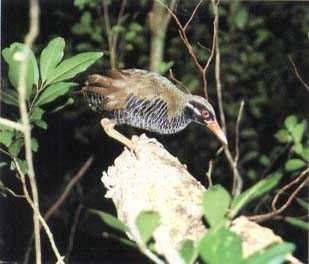
Domestic Endangered Species
(Rallas okinawae)
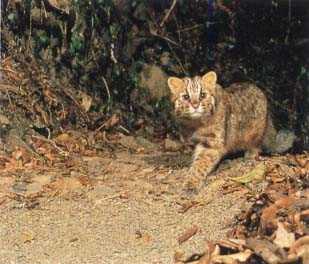
Domestic Endangered Species
(Felis euptilura)
- Habitat Conservation
Minister of the Environment designates the natural habitats of DES as "Natural Habitat Conservation Areas." These areas are classified into two types of zones: "Protection Zones" and "Monitoring Zones." In Protection Zones, Minister of the Environment regulates certain activities, such as construction or cutting trees. Monitoring Zones function as buffer zones.
- Rehabilitation of Natural Habitat and Recovery of Viable Populations
The Government may promote the rehabilitation of natural habitat and the recovery of viable populations of Domestic Endangered Species because the survival of endangered species cannot be achieved by regulating the acquisition and transfer of organisms nor controlling human activities in natural habitat. Ministry of the Environment will establish programs in cooperation with other Ministries and Agencies to promote the rehabilitation of natural habitats and the maintenance of viable populations. These programs may be implemented by Ministry of the Environment or, if appropriate, by other Ministries, Agencies, Local Governments, or NGOS.
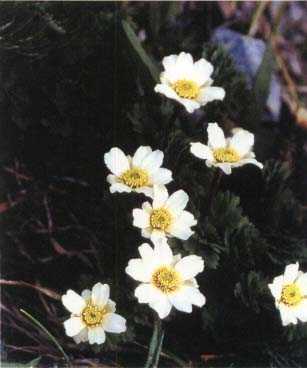
Domestic Endangered Species
(Callianthemum insigne var. hondoense)
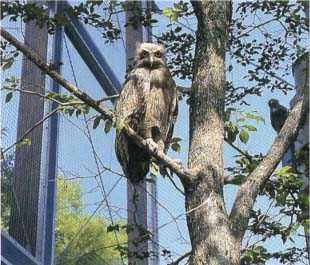
Domestic Endangered Species
(Ketupa blakistoni blakistoni)